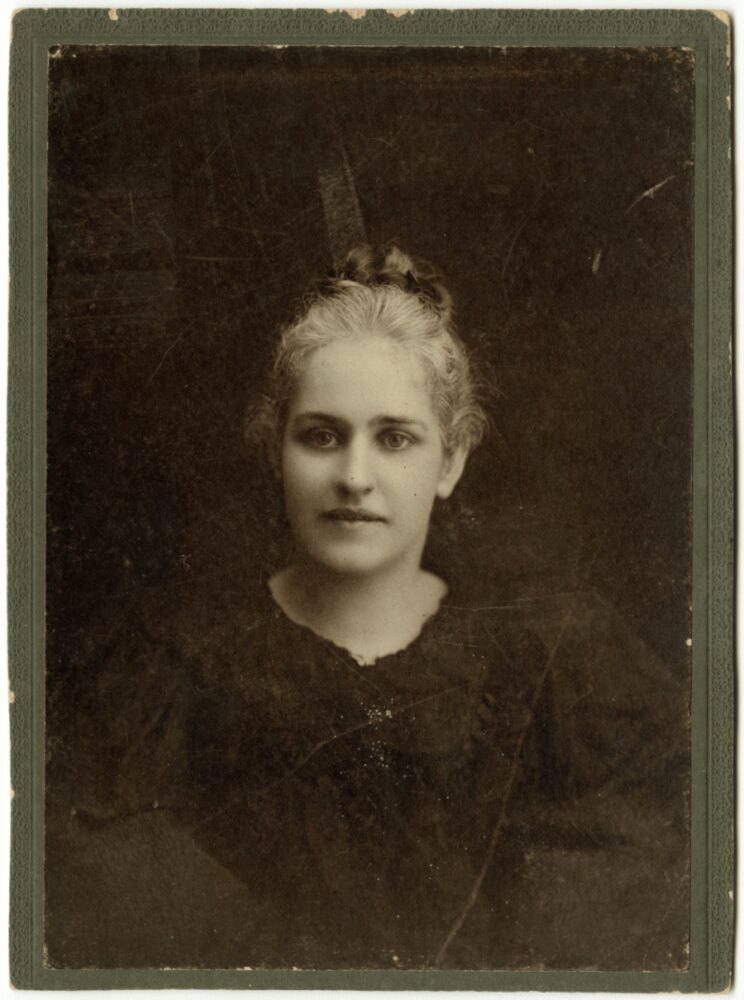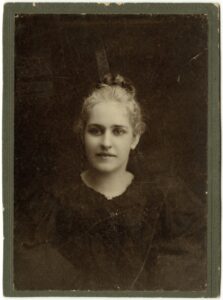Sophie B. Wright
A New Orleans educator and civic activist who embodied the complexities and racialized limits of white southern Progressivism.

The Historic New Orleans Collection
Sophie B. Wright, 1899.
Sophie B. Wright (1866–1912) was an educator and civic activist in New Orleans who embodied the complexities and racialized limits of white southern Progressivism. At a time when Louisiana barred women from voting and holding office, Wright used other political tools to broaden social welfare services, primarily for white New Orleanians. She advocated for public parks and improved sewerage systems and provided resources for children with disabilities through existing charities. She also founded a private school for white girls in 1881 and expanded educational and economic opportunity for white workers through a free night school she opened shortly thereafter. Her schools’ exclusion of Black students reinforced white supremacy during the Jim Crow era, as did her prominent role in the United Daughters of the Confederacy. With a street, a public school, and a public park named after her, Wright has remained in New Orleans’s memorial landscape long after her death. However, that presence drew criticism in 2020 as racial-justice protests renewed examinations of racism and historical memory.
Early Life and Educational Career
Wright was born June 5, 1866, to Mary Bell, a homemaker, and William H. Wright, a veteran of the Confederate Army. The family was impoverished, and their hardship deepened when Sophie severely injured her back and hips in a fall at age three. After using a wheelchair for six years, Wright transitioned to crutches, which she used for the remainder of her life. Crutches enhanced Wright’s mobility, enabling her to attend school for the first time at age nine. After just five years of schooling, Wright opened her own school for white girls at her family home at 141 Race Street in 1881. Wright, who was fourteen at the time, called the institution the Day School for Girls. Charging fifty cents per student per month, she netted ten dollars in the school’s first month.
In order to teach subjects beyond her own grammar-school education, Wright briefly returned to school. She enrolled in New Orleans’s segregated normal school for white students, a publicly supported institution that trained teachers. There, she studied languages while simultaneously teaching math to other normal school students and running her own private school.
In 1883 Wright changed her own school’s name to the Home Institute, and it soon outgrew its space in her family home. This growth occurred as the city’s post-Reconstruction school board slashed funding and sharply reduced public-school offerings. Meanwhile, the Home Institute moved into a succession of larger buildings over the next decade, and in 1894 the state authorized it to grant university-level “diplomas and degrees appertaining to letters and arts.” By 1897 the day school employed eighteen teachers for 180 female students, who ranged from the primary grades to college.
The Free Night School
Around 1884 Wright opened a free night school for white working men and boys, providing the basis for the New Orleans public school system’s renewed investment in evening education. While the public system included night schools for white students prior to the Civil War, officials later closed those schools due to financial constraints. Wright’s night school, which expanded to include white girls and women, ultimately enrolled 1,000–1,500 students per year and educated more than 25,000 students during its twenty-five-year existence.
Wright reportedly created the school in response to a request from an adult acrobat who had run away with the circus in his youth. After seeing the sign that read “Day School for Girls” outside of Wright’s home, he asked whether he could receive lessons too. The acrobat hoped to take the civil-service examination, and he believed schooling would allow him to pass the test and secure a better job. While this often-repeated anecdote may be not be entirely true, the night school’s impact is well-documented.
The night school’s popularity propelled Wright to move both of her schools to their longtime home in the 1400 block of Camp Street in 1895. The location in the Lower Garden District placed the night school near factories and foundries, and its roster filled with newsboys, mechanics, and millhands. As many students were recent immigrants, Wright hired bilingual teachers to offer courses such as bookkeeping and stenography as well as math and reading.
While Wright initially covered the free night school’s costs with tuition from the day school, wealthy benefactors assisted after the purchase of the Camp Street facility strained her finances. Beginning in 1897 philanthropists provided $2,000 annually for the school’s operation. Additional donors contributed $10,000 in 1904 to pay off Wright’s mortgage. That gift celebrated Wright’s receipt of the Daily Picayune’s Loving Cup, which the paper awarded annually to a top philanthropist.
Wright’s night school closed in 1909, by which point the public schools had reestablished evening schools for white workers. The system’s renewed investment in white evening schools contributed to the widening gap between public expenditures for white and Black education. Despite repeated pleas from Black New Orleanians, the school board did not open a Black evening school until 1918.
United Daughters of the Confederacy
Wright’s educational and philanthropic work did not simply unfold within the racially inequitable structures of Jim Crow New Orleans. As her leadership within the United Daughters of the Confederacy (UDC) attests, it also institutionalized those structures. Wright hosted meetings of the UDC’s Stonewall Jackson Chapter of New Orleans at her home, and she served as the chapter’s inaugural president upon its formation in April 1908. Like UDC chapters nationally, Wright’s chapter celebrated the Confederacy’s defense of white supremacy and falsely recast its rebellion against the United States as a noble defense of “state’s rights” rather than a fight to preserve slavery. The UDC advanced these ideas by fundraising for Confederate monuments and seeking to reshape the content of history textbooks. In September 1908 Wright’s Stonewall Jackson Chapter honored the Reconstruction-era White League, which fought to overthrow Louisiana’s Republican government during the 1874 Battle of Liberty Place.
The UDC’s support for white supremacy and its distortion of Civil War history stood in marked contrast to ideas that Black citizens advanced during these same years. Black progressives such as New Orleans’s Comité des Citoyens (Citizens’ Committee) fought to preserve Black people’s constitutional rights while national leaders such as Frederick Douglass criticized the “many disguises [that] have been assumed by the South in regard to that war.”
A Contested Legacy
In addition to her educational and UDC labors, Wright lectured nationally through Chautauqua societies and spearheaded the efforts of charitable organizations such as King’s Daughters on behalf of children with disabilities and the poor. These activities garnered widespread support from white New Orleanians. Upon her death in 1912, New Orleans’s only Black newspaper editor, Robert E. Jones of the Southwestern Christian Advocate, also published an admiring obituary. Following Wright’s death, the Home Institute remained open under the direction of two of her sisters.
New Orleans tributes to Wright, which began with the naming of a public high school for white girls in 1911, continued well into the twentieth century. In 1988 a statue of Wright by Enrique Alférez was installed in the park bearing her name. These honors received greater scrutiny during the 2020 racial-justice protests that transpired nationally. Protestors vandalized the Wright statute on July 10, 2020, and on February 24, 2021, the City Council Street Renaming Commission recommended renaming Sophie B. Wright Place. That same month the public school system launched its own initiative to rename buildings honoring slave owners, Confederate officials, and segregation supporters.
